
Winter Squash U-Pick Orchards in Madison area of Wisconsin in 2024, by county
Below are the U-Pick orchards and farms for winter squash that we know of in this area.
Not all areas of a state have winter squash farms that are open to the public. If you know of any others, please tell us using the add a farm form!
Remember to always check with the farm's own website or Facebook page before you go - or call or email them if they don't have a website or Facebook page. Conditions at the farms and crops can change literally overnight, so if you want to avoid a wasted trip out there - check with the farm directly before you go! If I cannot reach them, I DON'T GO!
PLEASE report closed farms, broken links and incorrect info using the "Report Corrections" form below.
New! As inflation remains high, see this page for
reliable (tested) brands of generic canning lids at lower
costs, and cost-saving measures for
getting fruit and vegetables and home canning.
If you are having a hard time
finding canning lids, I've used these, and they're a great price & ship in 2 days.
New! Road tripping and camping is a great way to have a fun, safe and inexpensive family trip. The national and state parks and monuments are open, and campgrounds usually cost between $10 and $40 per night. September to November is the best camping weather. See our new website Road Tripping and Camping.com for tips, tricks, guides, checklists and info about parks, monuments and other places to visit.
New! We just went live with our latest website, FunFactoryTours.com - As they name implies, you can find a fun factory tour, including chocolate, automobiles, historical forts and sites, famous buildings, Active Federal facilities even fun geology: like fossils and volcanic areas
Dane County
- The Tree Farm - asparagus, beans, beets, broccoli, carrots, Christmas trees, corn (sweet), cucumbers, eggplant (aubergine), flowers, peas, peppers, pumpkins, rhubarb, summer squash, winter squash, tomatoes, other vegetables.
8454 St Rd 19, Cross Plains, WI 53528. Phone: 608-798-2286. Email: treefarm@midplains.net. Open: May and June we sell asparagus and rhubarb by appointment; July and August we are open Wednesday, Thursdayand Friday, 9-noon and 4-8; Saturday and Sunday 9-5. Directions: The Tree Farm is located in Northwestern Dane County, WI, on Highway 19, four miles west of Highway 12. From Middleton take hwy 12 North and turn west \(that\'s left\) on hwy 19. From Sauk City take hwy 12 SE, turn south \(right\) on hwy KP and then east \(left\) on hwy 19. From Black Earth take hwy F north and turn east \(right\) on 19. See our website for a map and complete directions. . Click here for a map and directions. September and October we are open Wednesday, Thurs, and Friday 9-noon and 4-dusk; Saturday and Sunday 9-5 Thanksgiving we are open Friday 1:30 to 4:30; Saturday and Sunday 9-4:30 is located in Northwestern Dane County, WI, on Highway 19, four miles west of Highway 12. From Middleton take hwy 12 North and turn west (that's left) on hwy 19. From Sauk City take hwy 12 SE, turn south (right) on hwy KP and then east (left) on hwy 19. From Black Earth take hwy F north and turn east (right) on 19. See our website for a map and complete directions. Click here for a map to our farm. We raise approximately 40 different kinds of vegetables and herbs for you to pick as well as flowers to cut. A complete list of what we raise and when we expect it to be ready is available on our web site. We raise most vegetables that will grown in our climate. A complete list is available on our web site. (Updated December 22, 2010X)
Iowa County
- Bures Berry Patch, Inc. - pumpkins, winter squash, peas, strawberries, other vegetables
3760 W. Brigham Road, Barneveld, WI 53507. Phone: . Open: see their Facebook page. Click here for a map and directions.
Winter Squash
Winter Squash Picking Tips, Recipes and Information
Winter squash comes in many sizes, shapes and colors. Choosing a winter squash that meets your needs and the taste you will like can be tough without a guide! This page provides you that information, plus nutritional analysis and links to our freezing and canning pages!
Unlike its summer squash, which is best when harvested very young and used right away, winter squash is harvested at a mature age, which makes the outer skin hard and inedible. The skin, however, is protective and increases its storage life. Winter squash can be stored for 3 months or longer if kept in a cool dark place, like a basement or garage. I've had winter squash last a full year when stored like this!
The yellow and orange flesh of the winter squash is more nutritious and richer in vitamins, especially beta carotene, than summer squash. Winter squash is always served cooked and, because of its tough skin, only the inside flesh is eaten. The flesh, is sweet and great to make pie (pumpkins are a winter squash)
Size:
Choose a size based on your cooking needs. There's no difference in flavor based on size of the same variety of a squash.
Appearance:
For a quality squash, choose one that has a smooth, dry rind and is free of cracks or soft spots. Skin that is easily nicked or scraped with a fingernail means that the squash did not reach maturity. Look for rind that has a dull appearance. A shiny rind indicates that is has been picked too early or has a wax coating, which masks the skin. Choose squash that has a deep color and is heavy for its size. It is also best to choose squash with a firm, rounded, dry stem. Squash with no stem permits bacteria to enter.
Cut pieces can be found in the grocery market. Choose pieces that have a good interior color and finely-grained flesh that is not fibrous. Ideal flesh should be barely moist, but not too dry or too watery.
Storing Winter Squash
Winter squash has a long shelf life and can be stored for up to 3 months or longer in a cool, dry place between 55° and 60°F. A higher temperature will shorten storage time, but it will not alter the flavor. Storage temperatures below 50°F (as in a refrigerator) will cause squash to spoil more rapidly. If the squash needs to be refrigerated, it can be stored for 1 to 2 weeks. Cut pieces of squash should be tightly wrapped and refrigerated. Cooked, pureed squash can be frozen for use later as a side dish or to thicken, color, or flavor soups, sauces, or stews.
Varieties of Winter Squash
Here are a few of the most popular winter squash varieties; see this page for a complete master list of winter squash varieties.
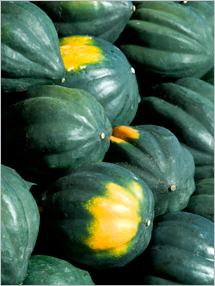 |
Acorn This acorn-shaped squash is one of the most widely available among the small winter squash. It measures about 6 inches around and weighs 1 to 2 pounds. Baking is an excellent way to bring out the sweet, nutty flavors of this tender fleshed squash. |
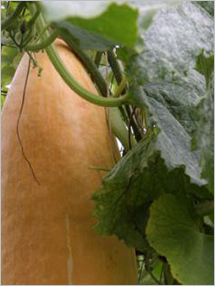 |
Banana This squash comes in three varieties: blue, orange, and pink. Among the three varieties, the pink banana is the most common in the United States. It is grown commercially in Florida. This large, thick-skinned cylindrical squash averages 20 inches long and weighs around 12 pounds. It is so large that it is usually sold in chunks instead of whole. Its creamy textured orange flesh offers a fruity and buttery delight to your palate. Although both baking and steaming are great ways to prepare this tasty squash, steaming produces a slightly sweeter, yet mild flavor. |
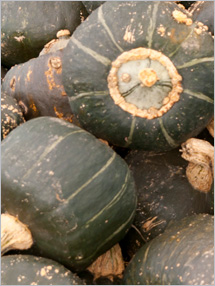 |
Buttercup This stocky squash is 6 to 8 inches in diameter, averaging 2 to 4 pounds. Its popularity stems from its sweet and creamy orange flesh. Its shortcoming is that it tends to be a bit dry. Baking or steaming can solve this problem; the dry flesh becomes smooth and tastes similar to a mixture of honey, roasted chestnuts, and sweet potato. Even more than baking, steaming softens the flesh and creates a thick puree (Great for pies) |
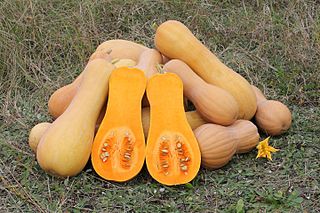 |
Butternut This elongated bell-shaped squash measures about a foot long and weighs an average of 2 to 4 pounds. Its popularity is due to its meaty, yet moderately sweet golden orange flesh. Because of its thin skin, this squash can easily be skinned with a vegetable peeler, which makes it easy to cut and prepare. Baking enhances its sweet, moist, and nutty flavors. Butternut squash is usually available from August through March. There are actually many variations of butternut. It can be used to make great "pumpkin" pies. |
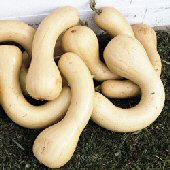 |
My favorite winter squash is one called
"Argos Gold", sometimes also simply called "Mexican Butternut" - it is
much longer than the usual "Waltham" butternut, often almost 2 feet long
and has a much sweeter taste and smoother texture. I've finally found
one supplier,
see this
page. I found another winter / butternut-type squash at Gurney's that looks promising . |
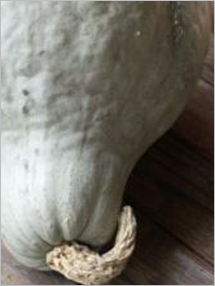 |
Hubbard This tear-shaped squash comes in several varieties: green (true), golden, blue, and baby blue. It ranges from dark green to orange and weighs from 5 to 50 pounds. Because of its size, Hubbard's popularity has decreased over the years. However, pre-cut portions of green and orange Hubbard can be found in markets. Green Hubbard's are thick, sweet, and dry. Golden Hubbard's; a smaller squash than the green or blue; are fairly sweet, but have a bitter aftertaste.The Blue or gray varietiey make wonder pumpkin pies! |
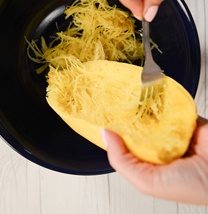 |
Spaghetti This oval-shaped yellow squash is also called the vegetable spaghetti. It averages 9 inches in length and may weigh 2 to 3 pounds. When cooked, the crisp, tender fhesh falls a apart into spaghetti-like strands that have a mild lightly sweet and fresh taste. Keep in mind that the larger the vegetable, the thicker the strands and the more flavorful the taste. It really is good with spaghetti sauce on the cooked squash "noodles" |
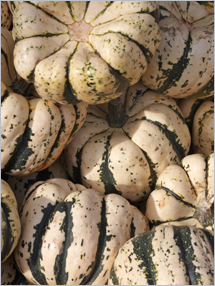 |
Sweet Dumpling This solid round squash, formerly known as the vegetable gourd, is a perfect serving for one person. It is about the size of an apple and weighs up to 1 pound. The skin is a warm cream color striped with ivy green, and it changes to butter color and orange during storage. The skin is relatively tender and can be eaten. The pale-yellow flesh is smooth, fine, and dry as a potato and produces a rich starchy, light to mild sweetness, with a slight corn flavor. |
Other Local Farm Products (Honey, Horses, Milk, Meat, Eggs, Etc.)
(NOT pick-your-own, unless they are also listed above)
- Farm markets and roadside stands
- Local Honey Finder
- Local Meat, Milk and Eggs
- Venues: Farms, Wineries, Orchards for your event, wedding or party
- Easter egg hunts
- Children"s consignment sales
- Fruit and vegetable festivals
- Winery tours and wine tastings
- Horse rides, stables, lessons, trails
- Maple Syrup farms and sugarworks
- Bed & Breakfasts on Farms, Wineries, Ranches and Orchards
- Pumpkin patches
- Corn mazes
- Zombie Paintball venues
- Christmas Tree Farms & lots
- Environmental resources
- Consumer fraud information
- Wholesale food sources
- Resources for Farmers
Looking for canning equipment and supplies?
Water bath canner with a jar rack
Pressure canners for gas, electric and induction stoves: Presto 23Qt or T-fal 22Qt
Canning scoop (this one is PERFECT)
Ball Blue book (most recent version)
Jars: 8oz canning jars for jams
Find Other types of farms:
Farm markets and roadside stands
Road trips and camping resources
Local Honey, apiaries, beekeepers
Consumer fraud and scams information
Home canning supplies at the best prices on the internet!
Maple Syrup Farms, sugarworks, maple syrup festivals
Environmental information and resources
Farms For Your Event for birthday parties, weddings, receptions, business meetings, retreats, etc.
Festivals - local fruit and vegetable festivals
Get the
most recent version of
the Ball Blue Book
With this Presto 23 quart pressure canner and pressure cooker, you can "can" everything, fruits, vegetables, jams, jellies, salsa, applesauce, pickles, even meats, soups, stews. Model 01781

You can make jams, jellies, can fruit, applesauce, salsa and pickles with water bath canners, like this Granite Ware 12-Piece Canner Kit, Jar Rack, Blancher, Colander and 5 piece Canning Tool Set

